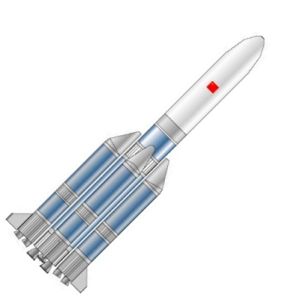
Home - Search - Browse - Alphabetic Index: 0- 1- 2- 3- 4- 5- 6- 7- 8- 9
A- B- C- D- E- F- G- H- I- J- K- L- M- N- O- P- Q- R- S- T- U- V- W- X- Y- Z
CZ-5
 CZ-NGLV-504 Credit: © Mark Wade |
AKA: Chang Zheng Next Generation Launch Vehicle Type D;CZ-5-5.0;CZ-NGLV-504;CZ-NGLV-D;Long March Next Generation Launch Vehicle Type D. Status: In development. Payload: 25,000 kg (55,000 lb). Thrust: 10,565.00 kN (2,375,106 lbf). Gross mass: 867,000 kg (1,911,000 lb). Height: 55.00 m (180.00 ft). Diameter: 5.00 m (16.40 ft). Span: 13.00 m (42.00 ft).
LEO Payload: 25,000 kg (55,000 lb) to a 200 km orbit at 52.00 degrees.
Stage Data - CZ-NGLV-504
- Stage 1. 4 x CZ-NGLV-300. Gross Mass: 147,000 kg (324,000 lb). Empty Mass: 12,000 kg (26,000 lb). Thrust (vac): 2,680.350 kN (602,567 lbf). Isp: 336 sec. Burn time: 160 sec. Isp(sl): 301 sec. Diameter: 3.35 m (10.99 ft). Span: 4.60 m (15.00 ft). Length: 26.30 m (86.20 ft). Propellants: Lox/Kerosene. No Engines: 2. Engine: YF-120t. Status: Development 2004. From top to bottom the 3.35-m Chinese new generation launch vehicle consists of a 90.7 cubic meter liquid oxygen tank, an intertank section, a 47.7 cubic meter kerosene tank, and an engine section with two gimbaled LOX /Kerosene engines of 1200 kN vacuum thrust each. The oxygen tank is pressurized using oxygen bled from the engine and helium is used to pressurize the kerosene tank. The engines can be throttled to 65% of rated thrust. Burn time shown assumes full thrust during engine burn.
- Stage 2. 1 x CZ-NGLV-500. Gross Mass: 175,000 kg (385,000 lb). Empty Mass: 17,000 kg (37,000 lb). Thrust (vac): 1,399.990 kN (314,730 lbf). Isp: 432 sec. Burn time: 480 sec. Isp(sl): 333 sec. Diameter: 5.00 m (16.40 ft). Span: 5.00 m (16.40 ft). Length: 31.00 m (101.00 ft). Propellants: Lox/LH2. No Engines: 2. Engine: YF-50t. Status: Development 2004. From top to bottom the 5-m Chinese new generation launch vehicle consists of a 117.3 cubic meter liquid oxygen tank, an intertank section, a 350.7 cubic meter liquid hydrogen tank, and an engine section with two gimbaled LOX /LH2 engines of 660 kN vacuum thrust each. The hydrogen tank is pressurized using hydrogen bled from the engine and helium is used to pressurize the oxygen tank.
Family: orbital launch vehicle. Country: China. Engines: YF-100, YF-77. Spacecraft: Chinese Space Laboratory. Stages: CZ-NGLV-300, CZ-NGLV-500. Agency: CALT.
2016 November 3 - . 12:43 GMT - . Launch Site: Wenchang. Launch Complex: Wenchang LC101. LV Family: CZ-NGLV. Launch Vehicle: CZ-5.
- Shi Jian 17 - .
Payload: SJ-17. Nation: China.
Class: Communications.
Type: Communications satellite. Spacecraft: DFH-4.
USAF Sat Cat: 41838 . COSPAR: 2016-065A. Apogee: 35,804 km (22,247 mi). Perigee: 35,771 km (22,227 mi). Inclination: 0.80 deg.
First launch from Wenchang Space Centre in Hainan. The CZ-5 configuration used four large liquid strapon boosters around a central 5 metre diameter core stage, with a second stage consisting of a stepped cylinder similar in configuration to the Delta 4/H-2A second stages. On this mission a Yuanzheng-2 third stage was also installed. The payload was Shi Jian 17, an experimental communications technology satellite with a secondary experiment to observe orbital debris. After launch at 1243 UTC the CZ-5 second stage achieved a 170 km parking orbit at 1257 UTC. At 1307 UTC the second stage made a six-minute-long second burn to 178 x 29127 km x 19.5 deg. The YZ-2 separated at 1313 UTC and shortly afterwards made a burn to 212 x 35802 km x 19.5 deg. YZ-2 then coasted to apogee and restarted at 1836 UTC to place itself in near geosynchronous orbit. The SJ-17 payload separated at about 1855 UTC into a 35886 x 38811 km x 0.8 deg orbit and drifted around the GEO arc. On Nov 12 it entered a 35771 x 35804 km geostationary orbit over 162.9E.
Back to top of page
Home - Search - Browse - Alphabetic Index: 0- 1- 2- 3- 4- 5- 6- 7- 8- 9
A- B- C- D- E- F- G- H- I- J- K- L- M- N- O- P- Q- R- S- T- U- V- W- X- Y- Z
© 1997-2018 Mark Wade - Contact
© / Conditions for Use